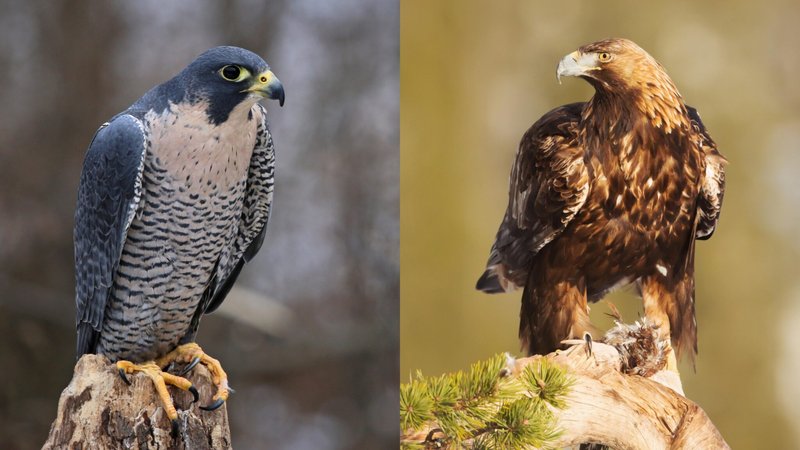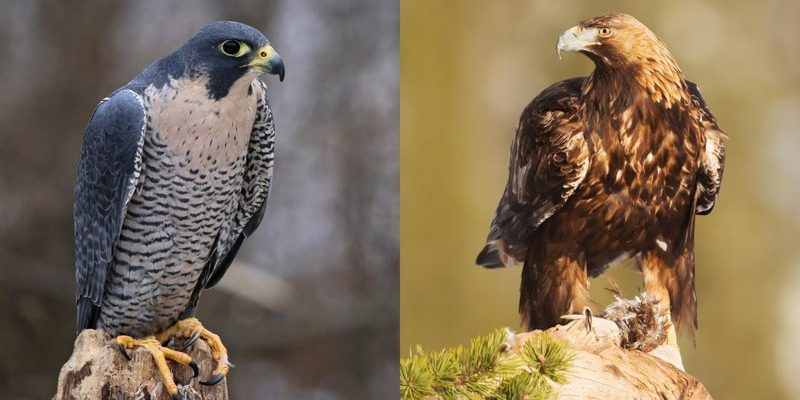
Just like how some cars are designed for speed while others prioritize comfort, bird species have evolved with different characteristics, adaptations, and lifestyles. In this article, we’ll explore the Golden Eagle and compare it to similar birds, such as the Bald Eagle, the Harpy Eagle, and even some hawks. By the end, you’ll not only know how the Golden Eagle stands out but also appreciate the fascinating variety of eagles and raptors that grace our skies.
What is the Golden Eagle?
The Golden Eagle is one of the most recognizable birds of prey. Found primarily in the Northern Hemisphere, these birds thrive in mountainous regions and open spaces. With a wingspan that can reach up to 7 feet, they are built for soaring long distances while hunting. Their feathers are predominantly dark brown, with a striking golden hue on the back of their head and neck, making them look regal in flight.
Golden Eagles are known for their incredible hunting skills. They primarily feed on small to medium-sized mammals, such as rabbits and ground squirrels. With keen eyesight that allows them to spot prey from great heights, they can dive down at speeds exceeding 150 miles per hour. This combination of size and agility makes them skilled hunters in their natural habitats.
Golden Eagle vs. Bald Eagle
When comparing the Golden Eagle to the Bald Eagle, the differences become quite pronounced. The Bald Eagle, a symbol of the United States, is primarily found near water and has a diet that mainly consists of fish. Its striking white head and tail stand in sharp contrast to its dark brown body, making it easily recognizable.
In terms of size, Bald Eagles are slightly larger, with a wingspan that can reach about 8 feet. However, they are not as agile in flight as Golden Eagles. While both species share some hunting territories, Bald Eagles often rely on their strong presence to steal fish from smaller birds rather than actively hunting. This shows a significant difference in hunting strategy, highlighting the unique adaptations of each species.
Golden Eagle vs. Harpy Eagle
The Harpy Eagle is another fascinating bird that shares an affinity for size and power with the Golden Eagle. Native to tropical rainforests in Central and South America, the Harpy Eagle is known for its striking appearance, with a large crest and formidable talons. They primarily hunt sloths and monkeys, showcasing their strength and ability to navigate dense forest environments.
While both eagles have impressive hunting skills, their habitats set them apart. The Golden Eagle prefers open terrains and mountainous regions, making it adaptable to different climates. In contrast, the Harpy Eagle thrives in rainforest ecosystems, relying on its powerful build to hunt in a less accessible environment. This leads to differences in prey choice and hunting techniques, further diversifying the eagle family.
Golden Eagle vs. Red-tailed Hawk
Although they belong to different genera, the Red-tailed Hawk often comes up in conversations about birds of prey. With their characteristic reddish tail and broad wings, they are commonly seen soaring over open fields across North America. While the Red-tailed Hawk is smaller than the Golden Eagle, it shares the same hunting prowess and keen eyesight.
What sets them apart is their size and hunting habits. The Golden Eagle, as a larger bird, targets bigger prey, while the Red-tailed Hawk mainly feeds on rodents and smaller birds. Their hunting techniques also differ; Golden Eagles often hunt by diving from great heights, whereas Red-tailed Hawks utilize a more stationary hunting method, watching from high perches.
Habitat and Range: Where Do They Live?
Understanding where these birds live can significantly help us appreciate their behaviors. The Golden Eagle is found across various landscapes, including mountains, grasslands, and even some urban areas, showing its adaptability. From North America to parts of Europe and Asia, these eagles roam vast territories, often nesting on cliffs or tall trees.
In contrast, the Bald Eagle prefers habitats near large bodies of water, where it can easily find fish. The Harpy Eagle is exclusively found in tropical rainforests, while the Red-tailed Hawk can adapt to urban areas, fields, and deserts. By examining their habitats, we can see how environmental conditions shape their lifestyles and hunting strategies.
Conservation Status: What’s Being Done?
Conservation efforts play a crucial role in ensuring that these magnificent birds thrive. While the Golden Eagle is relatively stable and not currently endangered, habitat loss and hunting pose threats. Organizations are working to protect their habitats and educate the public about the importance of maintaining ecological balance.
In contrast, the Bald Eagle faced significant decline due to habitat destruction and pollution, particularly from DDT pesticide. Thanks to concerted conservation efforts, such as banning harmful substances and protecting nesting sites, Bald Eagles have made a remarkable comeback. Harpy Eagles, however, remain vulnerable due to deforestation and habitat loss, underscoring the need for ongoing efforts to secure their future.
Cultural Significance: Eagles in Human History
Eagles, particularly the Golden Eagle and Bald Eagle, hold significant cultural meanings in various societies. The Bald Eagle has become a symbol of freedom and strength in the United States, representing the country’s spirit. The Golden Eagle, on the other hand, has historical significance in cultures such as Native American tribes, where it is seen as a messenger to the divine.
These birds often appear in folklore, art, and even sports logos, emphasizing their powerful presence in the human world. The reverence for eagles reflects not only their beauty but also the qualities we associate with them, such as courage, nobility, and keen vision.
Final Thoughts: Appreciating Our Feathered Friends
By exploring the differences between the Golden Eagle and its similar bird species, you can appreciate the diversity of natures’ avian wonders. Each bird has unique traits, hunting strategies, and habitats that contribute to the rich tapestry of life. Whether you’re an avid birder or just curious about wildlife, understanding these differences can deepen your appreciation for these magnificent creatures that fly high above us.
So the next time you spot a Golden Eagle soaring in the sky, remember: it’s not just about its impressive size or hunting skills; it’s part of a fascinating family of birds that continues to inspire awe in all of us. Keep looking up; you never know what incredible sights await in the skies!

